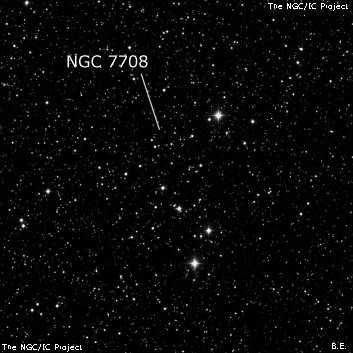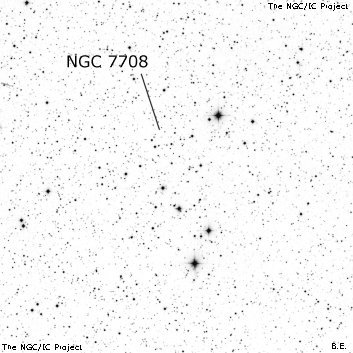NGC/IC Project Restoration Effort
(This is a very very beta version)
NGC7708


Basic Information
Location and Magnitude
Right Ascension: 23:35:0.0
Declination: +72:50:0
Constellation: CEP
Visual Magnitude:
Historic Information
Discoverer: Herschel W.
Year of discovery: 1787
Discovery aperture: 18.7
Observational
Summary description: Cl, L, P, lC, st 10…15
Sub-type: *Grp
Corwin's Notes
=====
NGC 7708. This is probably just a random group of stars. The NGC position,
from two observations by JH, is for HD 221774, the 8th magnitude star
mentioned in the NGC description. The other fainter stars seem to be
scattered more to the north, and the extent of the "cluster" is indefinite on
the POSS1. Perhaps it would appear better at the eyepiece.
-----
Looking again at this in May 2016, I am more inclined to agree with the
Herschels -- this looks like a pretty nice cluster.
I am unsure, however, whether the two or three brightest stars -- HD 221774,
BD +71 1211, and BD +71 1212 -- are cluster members or not. The usual study
with astrometry, photometry, and spectroscopy will be needed to tell us. In
the meantime, I've given two positions -- one with the stars (which I finally
adopted for the cluster), and my earlier one without them. In either case,
the cluster looks to be more "cluster-ish" (as George Abell once put it in a
different context) to me now than it did in the mid-1990s on the POSS1 prints.
Finally, Brent Archinal makes the "cluster" considerably larger, including a
scattered clump of 5-6 moderately bright stars 16-17 arcminutes to the east.
This might be the Herschels' cluster, though the only estimate of its size we
have is from JH on the final of the three nights on which he saw it: "It more
than fills the field." This implies a diameter of at least 15 arcminutes, but
I do not think that JH is saying it is as large as two field diameters. His
full descriptions read, "A poor and coarse cluster of large and small stars.
The largest (= 9m) taken"; "A star 8 or 8.9m [8-9m], the chief of a poor and
diffused cluster of small stars"; and "A * 8.9m, the chief of a scattered
cluster of 30....50 stars, 10....15m. It more than fills the field." WH says
only, "A cluster of coarsely scattered large stars, not rich, but the stars
are brilliant." His position is close to the center of the western clump, so
I am inclined here to accept that as the Herschels' object.
Steve's Notes
=====
NGC 7708
17.5" (12/20/95): large, scattered group that requires at low power. At 100x, about 30 stars are spread out in 15' triangular outline (borders are arbitrary) elongated NW-SE. �Includes one bright star (mag 7.4 SAO 10785) and a number of mag 11 stars. There are also two mag 8 and 9 stars (SAO 10788 and 10791) at the south vertex of the triangle. There are no rich spots but the group appears somewhat detached in the field at low power. Catches the eye because of the brighter stars although appears to be just an asterism due to lack of any concentration or rich spots. Listed as nonexistent in RNGC.



